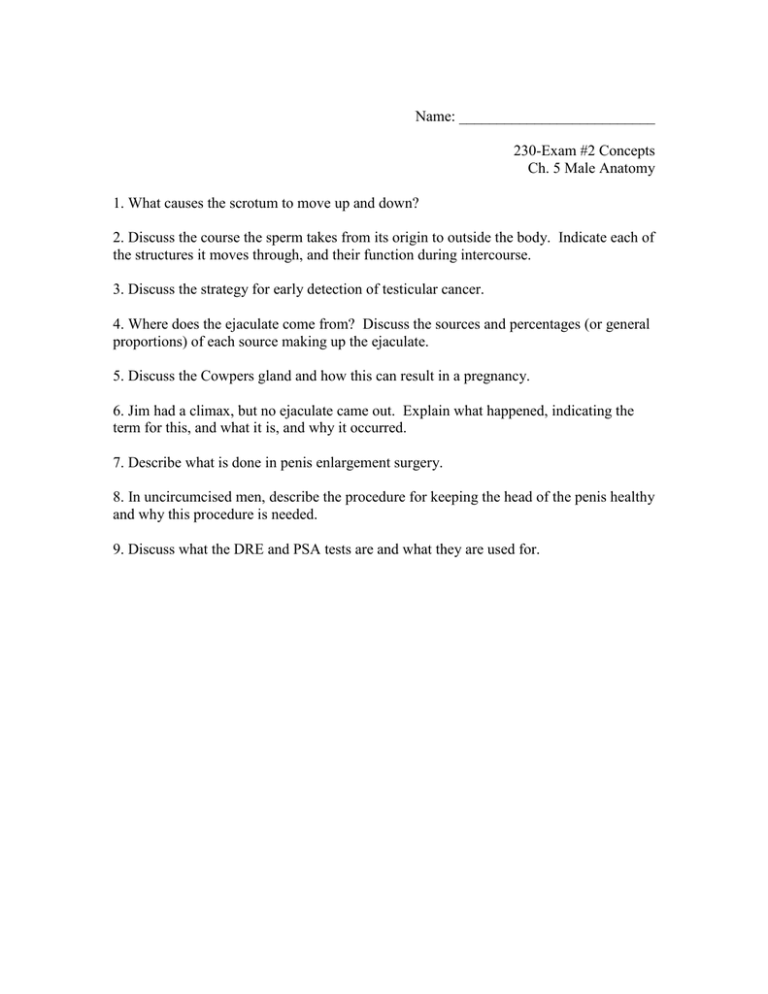
Name: __________________________
230-Exam #2 Concepts
Ch. 5 Male Anatomy
1. What causes the scrotum to move up and down?
2. Discuss the course the sperm takes from its origin to outside the body. Indicate each of
the structures it moves through, and their function during intercourse.
3. Discuss the strategy for early detection of testicular cancer.
4. Where does the ejaculate come from? Discuss the sources and percentages (or general
proportions) of each source making up the ejaculate.
5. Discuss the Cowpers gland and how this can result in a pregnancy.
6. Jim had a climax, but no ejaculate came out. Explain what happened, indicating the
term for this, and what it is, and why it occurred.
7. Describe what is done in penis enlargement surgery.
8. In uncircumcised men, describe the procedure for keeping the head of the penis healthy
and why this procedure is needed.
9. Discuss what the DRE and PSA tests are and what they are used for.
Name: __________________________
230-Exam #2 Concepts
Ch. 6. Sexual Arousal and Response
1. Discuss the effect of silence or noises on sexual arousal.
2. Discuss Helen Kaplan’s and Masters and Johnson’s models of sexual response. Next,
compare and contrast these two models.
3. Sally’s sexual interest has decreased considerably to almost nothing. Explain the
factors that may have contributed to this situation.
4. Discuss vasocongestion and its function for both sexes during intercourse.
5. If both sexes wrote their description of orgasm, what similarities or differences would
you see?
6. Discuss the Grafenberg spot. Indicate the location, how to find it, the possible source
of this tissue and why scientists feel this is the source.
7. Discuss the vaginal and orgasmic changes that occur as women age, and possible
solutions.
8. To be sexually active in your seventies, what should you do during your lifetime?
9. Discuss the sexual changes that occur with orgasm as men age.
Name: __________________________
230-Exam #2 Concepts
Ch. 7. Love
1. Discuss Sternberg’s theory of love.
2. In Sternberg’s theory of love, what changes occur over time in a relationship?
3. Discuss the characteristics of long-term successful marriages.
4. Discuss the difficulty in describing and discussing genital anatomy.
5. In love relationships, what factors are most important in creating a stable, long lasting
relationship?
6. In a study of 300 happily married couples, what reasons were given for the success of
the marriage?
7. Discuss active and passive listening and give an example of each.
8. Discuss “unconditional positive regard” and give an example of this.
9. Discuss the effect of a “why” question on the other person.
10. Discuss the process of giving and receiving criticism and how to produce closure to
this conversation.
Name: __________________________
230-Exam #2 Concepts
Ch. 8. Sexual Behaviors
1. Discuss erotic fantasies in relation to healthy sexuality and how they can affect your
relationship.
2. Discuss the beneficial effects of masturbation.
3. Over the years Jan’s partner has “performed” sex on her. As a result, she does not find
it enjoyable and doesn’t really know her own body, or what would please her. What
would you suggest to help her?
4. Discuss the relationship between frequent sex among people with partners and
masturbation.
5. What are the most and least common techniques of masturbation among women?
6. When natural vaginal lubrication is not sufficient, what types of lubrication should you
use, which should you not use, and why?
7. Discuss the two types of oral genital sex, using scientific terminology.
8. Discuss what you know about anal intercourse and oral anal sex. Include information
on risks, precautions, and orgasm.
9. What is the relationship between being lesbian or heterosexual and orgasm?
Name: __________________________
230-Exam #2 Concepts
Ch. 9. Sexual Orientation
1. Discuss Kinsey’s continuum of sexual orientation.
2. Discuss the research on the causes of sexual orientation.
3. Discuss the effects of giving other sex hormones to animals prenatally.
4. Discuss the research on twins and sexual orientation, indicating the meaning of these
results.
5. Discuss the American Psychiatric Association’s position on homosexuality and mental
illness.
6. Discuss the after effects of even “successful” gay conversion programs.
7. Discuss the gender role expectations in gay relationships compared to heterosexual
relationships.
8. Discuss the differences between gay and lesbian relationships regarding monogamy,
number of partners and number of sexual relationships.
9. In both homosexual and heterosexual relationships, what is the most important factor
in a love relationship?
10. The usual sexual orientation of children from gay and lesbian families is what?


